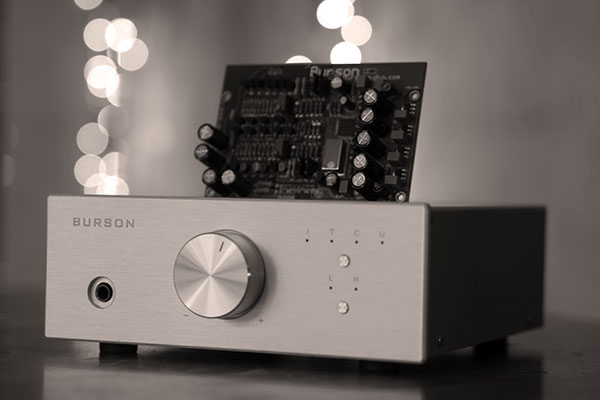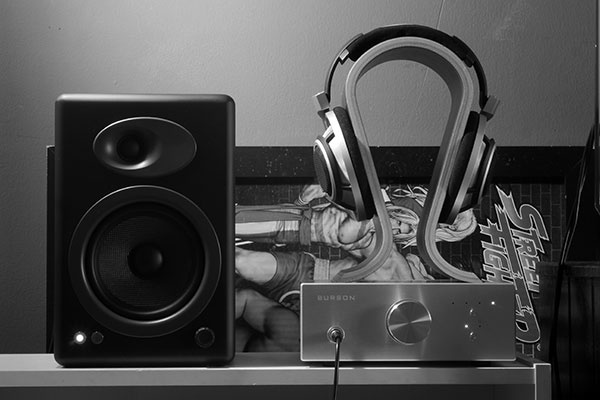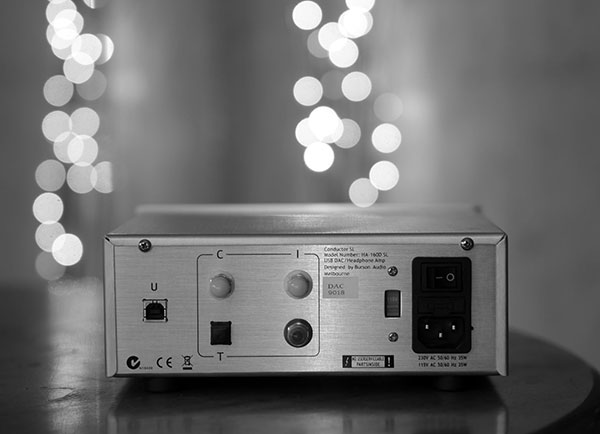The Burson Audio Conductor SL is a high-end solid-state desktop headphone amp & DAC featuring 2 DAC cards, an ES9018, and a PCM1793. It is priced at $1744.
Disclaimer: The Burson Playmate sent to us is a sample unit in exchange for our honest opinion. We thank the team at Burson for giving us this opportunity.
You can find out more about Burson products reviewed on Headfonics here.
Every once in awhile, the clouds part and the sky begins to gently glow, flowers bloom, angels cry and audiophiles around the world begin to sob with joy. It is really rare to find a USB Dac and amplifier combo with future proof upgrades that truly sets it apart from the rest.
Sometimes the journey to find that one amplifier, headphone, or source can take years to even decades to find. I’ve finally found my one Dac. Sure, the Burson Conductor SL ( $1300 ) is not the absolute best in the $2000 or so price tier, but it does offer one of the most beautiful and spacious presentations that I’ve ever heard.
This is a great USB Dac and Amplifier and I’ve enjoyed every second of my time with it.
Design
Brushed aluminum and high-quality steel adorn the entire body of the Burson Conductor SL, which is a modified and tweaked version of the standard Conductor that costs around $1900. Popping the hood off this beauty scares the hell out of me each time I try to remove the screws and gently peel off the top of the unit to replace one of two Dac chips I have for this specific model.
Everything screams high quality on the Conductor SL, top to bottom the Dac/Amp is exceptionally well made and designed with a simple yet elegant design. Once the hood is removed, you can see that Burson put a great deal of time and effort into the actual layout of the innards and the chipboard itself.
I’ve seen messy insides to a lot of expensive amps but Burson always designs the physical layout of their amplifiers as cleanly as possible. The entire internal structure has an almost artistic flare to it and I find it a quality that a lot of manufacturers don’t pay much attention to. It is clear a ton of development went into the Conductor series amplifiers and it is blatantly obvious that this SL model is no different. Stunning in every facet, inside and out.
I/O
The Conductor SL offers a standard 1/4 headphone output as well as RCA, and digital inputs at the back. You will not be able to plug your portable source into the Conductor SL and use the unit as a pure amplifier, it can only be used as a combination of both while directly plugged into a source feeding it digital audio via a Mac or PC.
This really saddens me to the core of my being because the sound presentation on this amplifier is sublime and I very much desire to tote the Conductor SL around to meets and use it with portable sources, CD players, or your pick of any non-USB oriented source. What a shame, no Dac, or Pre-Amp out function.
DAC Chipsets
The Burson Conductor SL can be outfitted with two Dac options: The 9018 or the 1793. Both are very different and offer tonally opposite flavors, each pairs well with certain types of audio gear and sell for roughly $300 each individually.
ES9018
The 9018 is a vibrantly pure, tonally balanced, and liquid-like chip that offers excellent pairing with the likes of the more neutral or natural headphones out there. Some purists absolutely love the sound this chip has through the Audeze LCD-3 ( $1945 ).
Offering exceptional transparency and plenty of kick, the experience with most headphones, in general, will only be heightened that much more with a chip that sounds like this.
With such a high level of clarity and purity comes a more reference tonality to the stereo presentation, a tonality that lacks musicality and warmth on the low end. This is a preference thing, so if you prefer the reference tone with a more solid and transparent sound approach, get yourself the 9018.
Bass
The low end of this Chip is moderate in quantity but lands a 10/10 in overall clarity. It pairs exceptionally well with the likes of the Sennheiser HD-800 and AKG K-812 headphones, so much so that I find no external amplification needed beyond the 2watts into 8 ohms that the Conductor SL offers.
For dynamic headphones up to 300 ohms, I don’t think you would have any issues at all with output power needs but you will want to up your game a little with another amplifier of sufficient quality to help out with those Planar Magnetic headphones from Hifiman.
My LCD-3 pairs extremely well with the 9018 and offers absolutely pristine quality and texture throughout the entire frequency spectrum. Top to bottom, the LCD-3 sounds stellar with a powerful, solid, and weighted feel to the bass.
I’ve found that on a flat and neutral EQ set up, the 9018 doesn’t provide much of a boosted low end at all yet remains tonally focused and concise no matter what headphone I am using with it. Due to being a basshead at heart, I always find myself cranking the bass up a bit, especially so with the Audeze LCD-3 and AKG K-812.
I’d liked to have seen Burson include a simple bass output dial for EQ boosting, maybe even a treble response dial as well but I may be asking for too much. They went for quality in the basics over offering as many additional features as they could.
Mids
I find them lacking in a sense with most of the headphones I own, due mostly because of that sky-high level of clarity in the midrange that really doesn’t set itself apart from the more moderate in quantity low-end experience.
On cans like the LCD-3, a set known for stellar midrange and bass, the experience is shoulder shrug worthy at best and I find myself yearning for more of a musical approach over the 9018’s more sterile approach to everything.
With regard to the vocal experience, it is shockingly clear and realistic depending on your headphone being used. With highly dynamic sets like the Sennheiser HD-800 or similar, the 9018 offers some seriously realistic and deep sounding experiences. The better the sound stage in the headphone, the better this chip is going to sound.
The Conductor prior to this SL model, as well as the HA-160, were both known for offering one of the most dynamic and well set up, spacious, and airy stereo images there ever was in headphone amplifiers or DACs.
Nothing really even came close and Burson was always known for having exceptional sound staging. the overall super dynamic and almost non-existent background of the Conductor SL makes for a very special combination pairing with the likes of the HD-800 or similar headphones with any sound staging reputations.
In a physical sense of the word, the Conductor SL is neutral ground in terms of placement of the midrange, it’s not overly forward but certainly is not lacking in location.
Treble
I find it a bit bright but far from annoyingly so. The 9018 offers vibrancy and a hint of brightness throughout the entire presentation, almost shimmering and glistening in the night sky. Like moonlight on a dark and calm lake after the sun sets, the 9018’s natural and hard to feel background makes for a more pronounced treble recreation.
I’m not a purist, nor am I into the reference tonality so I find this chip highly boring in general. However, the treble on this dac option is nothing short of beautiful. I would avoid usage with headphones like the Sennheiser HD-800 or AKG K-812 when it comes to treble response, as the 9018 is really unforgiving and will accurately push whatever the source material is emitting.
Sadly, if your headphone sounds like ice bullets being shot into your eardrums I would avoid the 9018 at all costs. It’s not the fault of the 9018 at all, it’s your headphones fault. The 9018 sounds fantastic with the Hifiman HE-6 ( $1299 ), a headphone with perhaps the most beautiful and well developed treble response of any headphone ever made.
The HE-6 treble makes the Audeze LCD-3 treble sound muffled and hissy, yet the LCD-3 is pretty good on the treble to begin with so that only tells the tale of how good the upper end on Burson’s 9018 dac chip really is.
PCM1793
With tonality opposite of it’s brother the 9018, the 1793 chip offers a respectful nod to the fantastic and famous HA-160 Burson released a while back. This chip tosses purist and reference flavoring right out the window and gives you a mildly colored and warm presentation.
I very much loved the HA-160, in fact, it was my primary home amplifier for many years. Naturally, I’d fallen in love with this Conductor SL the very first time I’d gotten a chance to hear it at a local meet. I saw the Conductor SL sitting there, calm and cool as most everyone else passed it by.
Patiently waiting for someone to make conversation, the owner and I struck up a friendship immediately. I really didn’t want to move and sat in that chair for a solid 15 minutes without a word while the owner fiddled with his phone and looked at me, smiling every so often. I was hooked. This was the best amplifier I’d ever heard in this price tier. Not only that, but it also was everything I’d always wanted my HA-160 to be.
Bass
Warm, gentle, colored, and loose by comparison to the 9018’s sterile approach. This guy is meant for fun and musicality, no question about it. When it comes down to it, the Conductor SL’s 1793 chip has by far the most engaging and soothing low-end experience I’ve ever had on a sub $2000 amplifier before.
It just does it so right and with respect to the source material, without being overly colored the 1793 is almost sun-kissed with the most gently musical coloration to the bass experience I’ve yet come across.
This chip will make almost any headphone sound musical and fun. With regard to the gack ugly and sterile bass type of the Sennheiser HD-800 for example, the 1793 converted the bass experience into something mildly enjoyable and that is something I’d never thought possible.
Audeze headphones sound so yummy through this dac option, as do most of the Denon headphones and even the Fostex TH900. All of the aforementioned have a pronounced bass experience that is amplified into a velvet-like, lush, and wildly expressive, highly textured, and broad experience.
Where the 9018 had a more precise bass that felt rock hard and solid, the 1793 bass feels lighter, airier, and more enveloping with just the right amount of coloration to be considered extremely musical.
Mids
There is definitely a mid-bloom effect here, as the 1793 sounds more forward and prominent than the 9018 by a fair degree. I find it extremely satisfying with mid-forward headphones in general and it will really help out with some of those recessed midrange headphone presentations.
I consider this one the better of the two dac options when it comes to vocals, as it offers a noticeably more soft and forgiving styling to the presentation. My Lawton Audio LA-D7000 Headphones ( A highly modified Denon D-7000 ) is nothing short of stunning with the 1793 and I refuse to use any other Dac with this headphone.
The two pair and combo with one another extremely well and the experience is not only fun and wildly engaging, but also clear enough to satisfy the inner audiophile. In most cases and with most headphones I currently have on hand, the 1793 mid-range experience was simply unyielding in lushness and I was unable to find a single headphone that sounded bad with it.
In fact, I found myself enjoying the likes of the Sennheiser HD-800 ( a headphone I am not fond of in the slightest ) a great deal. The extra few notches of coloration and forwardness really help the recessed tendencies the HD-800 has and I could easily consider the HD-800 my primary all arounder. I feel like that statement would shake a lot of my close friends to their cores, shocking them into disbelief…
Treble
Surprisingly bright by comparison to the 9018 but not in a negative sense of the word, it has some sparkled qualities to it along with some bite. However, it is light years away from ever being harsh or painful. Smooth, well-controlled and hyper-engaging are terms I’d use to describe the upper end of the 1793.
When it comes to clarity, it is very apparent that the 9018 is superior and noticeably more transparent, however it is flat and boring by comparison to the 1793 option. Despite the lack of clarity, I find myself not really wanting to use the 9018 with headphones that are well known for exceptional treble response, headphones like the Hifiman HE-500 or HE-6 for example.
These are headphones I will always use with the 1793 regardless of that noticeably inferior clarity across the board. I’d be very careful with the likes of the stock Denon D-7000, Sennheiser HD-700/800 and similar headphones with harsh treble response.
While I love my Denon D-7000 something fierce, I cannot possibly use the headphone without a hand-tailored EQ setup with a dropped treble response active at all times. Without my personal EQ via my Foobar2000 setup, I refuse to use headphones like the Sennheiser HD-800, AKG K-812, stock Denon D-7000/5000 and a few other mid-tiers with nasty upper ends.
Thank the audio gods for Lawton Audio and Dynamat, if not for their modifications that greatly reduce the treble response of the Denon D-7000, I would be extremely unhappy as both a man and an audiophile.
Stereo Imaging
Nothing in the sub $2000 range even comes close to the all-around staging properties the Burson lineup tends to have. The Conductor SL is the largest and most spacious sounding of the lot, but the standard Conductor and even the older HA-160 are no slouches. All are to be respected.
When used for Dac purposes outed to an external amplifier, the soundscape is almost always noticeably ruined. I’ve yet to come across another headphone amp that can compare to the Conductor SL’s magnificently airy presentation. It seems that the majority of audiophiles don’t really care for how vast the stereo image sounds, only that it’s realistic, and with that comes a universe and dimension ending paradox.
I just can’t seem to grasp the idea of why most amplifiers or even headphone companies do not invest more time into the stereo image width, height, and overall depth to the presentation.
Headphones like the Audeze LCD-series tend to have a very poor soundscape, something downright destroyed by the likes of the AKG K-812 and as a result the pairing of most Burson products with some of those closed in sounding Planar Magnetic headphones becomes much more enjoyable.
Expect some of the best soundstage width and height out there along with excellent spatial separation between instruments. Stereo Depth is the weak link in the chain. There are a few other amplifiers that do better, all be it more expensive than the Conductor but still in the general price tier that can outperform the overall realism factor and sense of extension into the room itself in a forward sense of the word.
Our Verdict
To date, the Burson Conductor SL is without question my absolute all-time favorite Dac and Amplifier combo under $2000. 2watts of output power is more than enough to drive most of the Planar Magnetic headphones with the Hifiman HE-6 as the exception, so I have absolutely no desire to stack another amplifier on top of the Conductor SL and use the unit purely as a Dac.
Most of my primary headphones are easily driven and mildly efficient so the Conductor SL all by its lonesome is overkill in regard to the driving power needed, that combined with the exceptional stereo imaging and clarity potential makes for an almost perfect amplifier and dac.
The SL is not without faults though, at this price there is absolutely no excuse for having no audio input functions at all, nor are there any excuses for not having a dedicated treble and bass switch of some type.
Not everyone uses Foobar2000 ( a software with unrivaled EQ possibility ) and most will be forced to deal with a flat EQ setup via their source and headphone. I’d rather have the dac or amplifier itself provide me with some boost options if I want it.
Offering flexible tonality, clarity and styling the Burson Conductor is my personal end-all amplifier combination and will be recommended for years to come without hesitation. I’ve loved every moment with this model and I cannot see myself purchasing anything else for a very long time.
In combination with my Lawton Audio LA-D7000 headphones and the 1793 installed onto the chipboard of the Conductor SL, the experience is beyond words and something I’ve sought since the very beginning of my audio journey. Highly recommended and worth every penny and more. Great job, Burson!
Burson Audio Conductor SL SPecifications
- Max Output Power @ 8 Ohm : 2W ; VOS Output Stage : 2 Levels / DAC Out : No
- Pre-Amp Out : No ; RCA input set : 1 ; Volume Control : ALPS Pots
- Enclosure : 2mm Folded Aluminum ; Stocked DAC PCB : PCM1793 ;
- DAC Spec: 24bit 192K
- DAC DNR: 113 db





